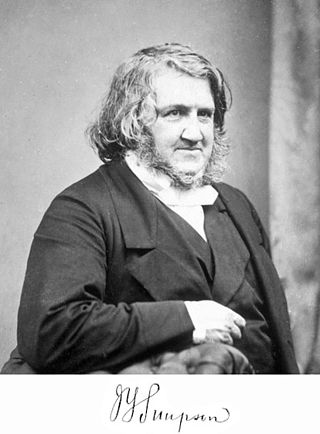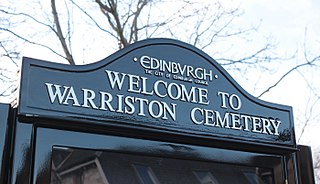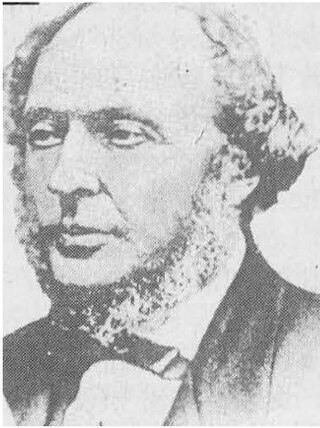
The Dean Cemetery is a historically important Victorian cemetery north of the Dean Village, west of Edinburgh city centre, in Scotland. It lies between Queensferry Road and the Water of Leith, bounded on its east side by Dean Path and on its west by the Dean Gallery. A 20th-century extension lies detached from the main cemetery to the north of Ravelston Terrace. The main cemetery is accessible through the main gate on its east side, through a "grace and favour" access door from the grounds of Dean Gallery and from Ravelston Terrace. The modern extension is only accessible at the junction of Dean Path and Queensferry Road.
The year 1847 in science and technology involved some significant events, listed below.

Sir James Young Simpson, 1st Baronet,, was a Scottish obstetrician and a significant figure in the history of medicine. He was the first physician to demonstrate the anaesthetic properties of chloroform on humans and helped to popularise its use in medicine.

Naguib Pasha Mahfouz is known as the father of obstetrics and gynaecology in Egypt and was a pioneer in obstetric fistula.
Events from the year 1847 in Scotland.
Events from the year 1847 in the United Kingdom.

Dr David Berry Hart FRSE FRCPE was a Scottish gynaecological surgeon and academic.

Sir William Overend Priestley was a British physician and Conservative Party politician. He served as Member of Parliament (MP) for Edinburgh and St Andrews Universities from 1896 to 1900.

Warriston Cemetery is a cemetery in Edinburgh. It lies in Warriston, one of the northern suburbs of Edinburgh, Scotland. It was built by the then newly-formed Edinburgh Cemetery Company, and occupies around 14 acres (5.7 ha) of land on a slightly sloping site. It contains many tens of thousands of graves, including notable Victorian and Edwardian figures, the most eminent being the physician Sir James Young Simpson.

Dr James Matthews DuncanFRS FRSE FRCP FRCPE LLD was a Scottish physician, known as a practitioner of and author on obstetrics.
The Royal Physical Society of Edinburgh was a learned society based in Edinburgh, Scotland "for the cultivation of the physical sciences".

Sir John Halliday Croom FRSE PRCPE PRCSE was a Scottish surgeon and medical author. He served as President of the Royal College of Surgeons of Edinburgh.

James Haig FergusonLLD FRSE FRCPE FRCSEd was a prominent Scottish obstetrician and gynaecologist. He served as President of the Royal College of Surgeons of Edinburgh from 1929 to 1931 and was president of the Edinburgh Obstetrical Society. He chaired the Central Midwives Board of Scotland and was manager of Donaldson's School for the Deaf. In 1929 he was a founding member of the British College of Obstetricians and Gynaecologists.
Robert Halliday Gunning FRSE PRPSE FSA LLD was a Scottish surgeon, entrepreneur and philanthropist. He did much to improve social conditions in Brazil and also became rich there. He endowed numerous prizes and awards including the Gunning Victoria Jubilee Prizes. The University of Edinburgh provides scholarships under the title of Gunning Victoria Jubilee Bursaries. He was a close friend of both Thomas Chalmers and Robert Christison.
Obstetric anesthesia or obstetric anesthesiology, also known as ob-gyn anesthesia or ob-gyn anesthesiology, is a sub-specialty of anesthesiology that provides peripartum pain relief (analgesia) for labor and anesthesia for cesarean deliveries ('C-sections').

Robert Milne Murray FRSE FRCPE FRSSA was a Scottish surgeon and medical author. Specialising in gynaecology he ran the Edinburgh Maternity Hospital and Simpson Memorial Hospital, He was the first medical Electrician at the Edinburgh Royal Infirmary but refused to patent any of the devices which he created and instead openly showed the apparatus to vising European colleagues to be freely copied.

Gustavus Charles Philip Murray was a British obstetrician who may have been the inspiration for Luke Fildes' 1891 painting The Doctor. His work in the examination of pregnant women was recognised by Adolphe Pinard in 1889 but ignored in England. He was popular with his patients and had a thriving practice with many professional appointments but as a result wrote little. He died at the age of 56 years from heart failure.

Francis James Browne (1879–1963) was professor of obstetrics and gynaecology and first director of the obstetric unit at University College Hospital, London, which was opened in 1926. He was known as "FJ".

Benjamin Philip Watson FRCSEd, FRCOG, FACS was a Scottish obstetrician and gynaecologist who was the head of academic departments in three countries. He was professor and departmental head successively in Canada, Scotland and the United States. In each of these posts he made undergraduate teaching a priority and reformed training in the speciality.

William Flockhart, L.R.C.S.E. was a Scottish chemist, a pharmacist who provided chloroform to Doctor James Young Simpson for his anaesthesia experiment at 52 Queen Street, Edinburgh on 4 November 1847. This was the first use of this chemical on humans when Simpson tried it on himself and a few friends, and then used it for pain relief in obstetrics, and surgery. This changed medical practice for over a century, according to the British Medical Journal.















